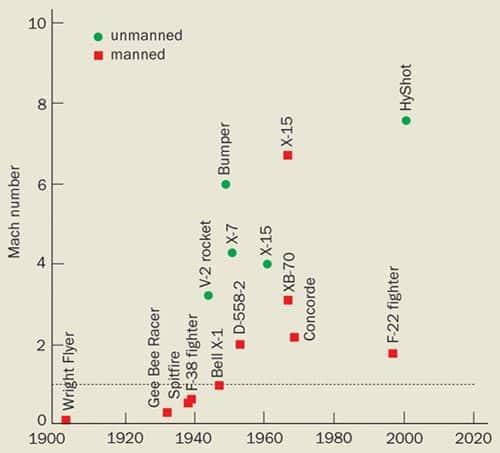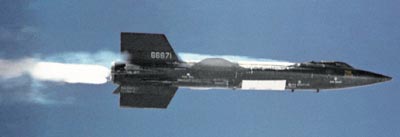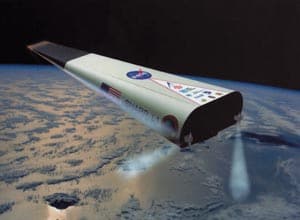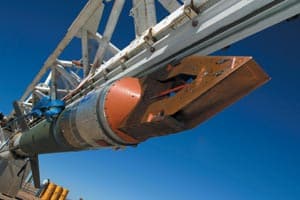A hypersonic plane would reduce the time taken to travel between any two places on Earth to just two hours, but fighting the forces of friction is pushing aerodynamics to its limits

Orville Wright’s history-making flight carried him a little over 36 metres in the 12 seconds that he spent in the air above the sands of Kitty Hawk. As we mark the centenary of that flight – which coincides with the demise of the world’s only supersonic passenger jet, Concorde – numerous efforts around the world are under way to develop aircraft that could travel a thousand times faster than the Wright Flyer. Such hypersonic vehicles could provide reliable, low-cost access to space and would also have potential military applications. However, the ultimate hypersonic promise is high-speed commercial transportation between any two locations on the planet, or even beyond.
Hypersonic flight is not new. The first man-made object to reach hypersonic speeds was the two-stage US “Bumper” rocket, which was assembled from a captured German V-2 rocket in 1949 – one year after Orville Wright’s death. Indeed, humans have been flying hypersonically for over four decades. Astronauts and cosmonauts have all reached hypersonic speeds while passing through the atmosphere on their way to or from orbit.
What distinguishes current research, however, is the focus on sustained hypersonic flight within the atmosphere. The Space Shuttle punches through the atmosphere as quickly as possible on its way into orbit, but a hypersonic craft would remain well within the Earth’s atmosphere throughout most of its ascent. Whereas the Shuttle uses the thrust of its engines to fight the force of gravity, a hypersonic vehicle would use the aerodynamic lifting force generated on its wings and fuselage. This vision of sustained hypersonic flight requires air-breathing engines, which have a high efficiency because they scoop oxygen from the atmosphere rather than from an onboard tank.
Air-breathing to orbit
There is a staggering list of technical challenges that must be overcome before hypersonic vehicles will fly. These range from designing high-speed air-breathing engines to developing materials and cooling systems that can handle the intense heat generated by the friction between the aircraft and the surrounding air. Aerospace engineers around the world have been studying these issues for over half a century, with a few notable successes amid some well publicized failures. The list of failures is a veritable graveyard of vehicles that were never built, either due to unsolvable technical challenges, insufficient funding or both. These include the US X-20 space plane from the 1960s, the UK shuttle proposal “HOTOL”, and the more recent X-30 and X-33 vehicles. Successes include the X-15 rocket plane in the 1960s and the HyShot engine that had a recent test flight in Australia (figure 1).
So why is there such renewed interest in hypersonics today? In part, persistent efforts have led to a number of hypersonic milestones, including successful ground experiments and flight tests. Moreover, there is a sense of optimism among those working in the field that the political climate is right for the continued support of hypersonic research. In the US at least, hypersonics is being backed by high-ranking individuals in the Department of Defense, while NASA has also expressed strong interest. And, of course, the tragic loss of Space Shuttle Columbia has focused attention on the need for improved access to space. Hypersonic air-breathing vehicles may offer a very attractive and potentially safer alternative to traditional rockets, making the flight into orbit more like a routine plane flight and less like the expensive, manpower-intensive launch process that it is today.
The motivation for air-breathing flight is very simple: why carry oxygen inside the aircraft if it is readily available in the surrounding environment? Most of the weight of a rocket, such as the Space Shuttle, is due to the oxygen it carries. An air-breather could eliminate this weight and that of the associated tanks. Flying like a plane should also be inherently safer than a rocket because planes can turn round and land, whereas a rocket is generally committed once its engines ignite.
Rocket engineers seek to improve a launcher’s performance by either reducing the weight of the rocket or improving the engine. NASA’s X-33 programme, for example, attempted to demonstrate such technologies with a novel “aerospike” engine and fuel tanks made from advanced non-metallic composite materials. But engineers were ultimately unable to build lightweight tanks that could hold extremely cold liquid fuel, and the programme was cancelled in 2001.
In contrast, hypersonic engineers seek to improve launch vehicles by greatly increasing engine performance, albeit at the expense of added weight. For a given rate of fuel consumption, an air-breathing engine can deliver four times as much thrust as a rocket engine, simply because it does not carry the oxidizer along with its fuel. Such engine performance could lead to dramatic reductions in the cost of sending people or objects into orbit, and may one day enable craft to reach orbit with a single fuel stage.
Hypersonics and the Mach scale
Aerodynamicists characterize flight speed in terms of Mach number, which is the actual speed of the vehicle divided by the speed at which sound moves through air. An aircraft travelling exactly at the speed of sound is therefore flying at Mach 1, while supersonic speed is anything greater than Mach 1. There is no set definition of the term “hypersonic” but it is generally applied to flight speeds that are in excess of five times the speed of sound – more than twice as fast as Concorde. Most commercial airliners fly at the relatively modest speed of Mach 0.85, and even high-performance jet fighters rarely exceed Mach 1.5.
An aircraft flying at Mach 10 could travel between any two locations on the globe in under two hours, and at Mach 24 – the holy grail of hypersonic flight – an aircraft would have the same speed as an object in orbit round the Earth, about 7.5 km s-1. With just a small push out of the atmosphere, which would require rocket engines, the aircraft could reach the altitude of the Space Shuttle or rendezvous with the International Space Station.
The use of Mach number to characterize flight speed is rooted in the basic physics of fluid flow. The speed of sound is the speed at which pressure disturbances can be transmitted in a fluid such as air. It is also an indication of the average speed of molecules in that fluid. As an aircraft flies through the atmosphere, air is displaced and this creates pressure disturbances and local changes in velocity. In subsonic flight these disturbances move faster than the vehicle itself. Each portion of the flow is therefore affected by both the presence of the vehicle and the disturbances that it creates in the surrounding fluid (figure 2).
In supersonic flight, however, the vehicle travels faster than the pressure disturbances it creates. As a result, an aircraft creates a sudden discontinuity in pressure and temperature called a shock wave as it breaks the sound barrier. This shock wave separates the undisturbed region in front of it (upstream) from the perturbed flow behind it (downstream). The presence of shock waves round a supersonic aircraft changes the basic aerodynamics of flight and therefore demands a different set of analytical tools from those of subsonic flight.
One important consequence of supersonic shock waves is an increase in drag, or resistance, to motion through the air. All aircraft (and fast-moving cars and trains) must fight drag forces. The drag of a subsonic plane is primarily due to friction with the air, as well as the pressure difference between the front and trailing surfaces. At supersonic speeds, drag is increased by the formation of shock waves that dissipate energy. The blunter the leading edges of the aircraft, the stronger the shock waves will be and the greater the drag.
Unlike the transition from subsonic to supersonic flight – which is marked by distinct changes in the basic physics of fluid behaviour – the transition from supersonic to hypersonic speeds is less clearly defined. For instance, shock waves are pressed very close to the surface of an aircraft in hypersonic flight, which means that the air round a hypersonic vehicle will become very hot due to friction. Indeed, the temperature can get so high that chemical reactions may occur that change both the composition and behaviour of the surrounding flow.
Chemical reactions can alter the pattern of flow round the vehicle, and can change how hot the surface becomes. At extreme hypersonic speeds, air molecules can even become ionized, which leads to the familiar “blackout” phase that hinders radio communication with returning spacecraft. The exact speed at which these phenomena take place depends on the specific geometry of the vehicle, which is why the definition of “hypersonic” is so imprecise.
Learning not to burn
The designer of an efficient supersonic aircraft must take shock waves into account, and will generally select a slender, sharp geometry, such as that of Concorde, which keeps the shock waves as weak as possible. At hypersonic speeds it is even more important to control the strength of shock waves, and this leads to an entirely different design philosophy for hypersonic aircraft compared with their more conventional cousins.
Behind a hypersonic shock wave the temperature at the leading edge of a hypersonic craft scales inversely with the square root of its radius of curvature. In other words, the sharper the leading edge of the vehicle, the hotter it will get. This is why spacecraft are designed with rounded noses and very blunt wings – characteristics that also increase the drag force. Air-breathing hypersonic vehicles are not able to tolerate this added drag, and so they will be built with sharp leading edges instead.
When a Space Shuttle returns from low-Earth orbit, the atmosphere begins to have a noticeable effect while the craft is still travelling at Mach 24. The blunt leading edges of the Shuttle offer poor aerodynamic performance but generate relatively low temperatures of 1400 °C. This is a modest temperature by hypersonic standards, but still hot enough to melt the structure of the vehicle if the heat-protective tiles are breached, as they were on Columbia.
The Apollo missions entered the Earth’s atmosphere at an even sportier Mach 36 when they returned from the Moon. The craft survived the journey – during which they reached peak temperatures of 2700 °C – with a rounded, blunt heat shield covered with ablative material, which evaporated away to dissipate heat. Indeed, blunt space probes have flown even faster than this – up to Mach 65 for the unmanned probe that the Galileo spacecraft dropped into the atmosphere of Jupiter in 1995. Note that the rest of the Galileo spacecraft was completely destroyed when it recently (and deliberately) crashed into Jupiter’s atmosphere because it lacked a heat shield.
In contrast to these ungainly flyers, the next generation of hypersonic craft will be designed to accelerate and to fly through the atmosphere with minimum drag. These vehicles will have slender shapes that can slice through the atmosphere. They will need very thin leading edges at the front and wing surfaces that can withstand temperatures far in excess of those experienced by the Space Shuttle.
Riding the hypersonic wave
An accelerating hypersonic vehicle with thin wings has already been built and flown – NASA’s X-15 rocket plane (figure 3). Three of these remarkable craft made a total of 199 flights between 1959 and 1968, including one in 1967 that reached Mach 6.7. The wings and body of the X-15 were made of high-temperature metal alloys, but they still had to be coated with special ablative coatings to survive the highest speeds. The leading-edge temperatures on the next generation of hypersonic craft will push material performance to the limit of our technology, and in some cases the leading edges will require complex active-cooling systems. But there is reason to be optimistic.
At the NASA Ames Research Center in California, materials engineer Daniel Rasky heads a team that has successfully flight-tested advanced ceramic materials on sharp hypersonic leading edges. This work has resurrected decades-old research into advanced materials that had been abandoned by the US Air Force, and has already shed new light into the physics of sharp hypersonic leading edges. Ted Paquette and colleagues at Refractory Composites Inc – a small company in Maryland – have also carried out pioneering work in high-temperature materials and cooling technologies with advanced ceramic materials. Among these are carbon-fibre-reinforced silicon carbide that can handle temperatures up to 1500 °C, and hafnium-based materials for use up to 1750 °C. These materials also have superior mechanical properties compared with Shuttle-era technology and they do not break down when exposed to oxygen.
Various companies and universities in Japan and Europe, including Snecma in France and Wacker Ceramics in Germany, are also pushing back the manufacturing, fabrication and performance limits of high-temperature materials for hypersonic flight. Researchers at Snecma, for example, are specifically developing high-temperature parts for the inside of a hypersonic engine.
Incorporating the sharp aerodynamic configurations of hypersonic flight into an aircraft means adopting a whole new design paradigm. Instead of fighting the shock wave, we need to use it to our best advantage. One very promising design is the so-called waverider airfoil, which actually rides on top of its own shock wave for highly efficient flight. Like most things hypersonic, waveriders are not a new idea – they were first proposed by Terry Nonweiler at Glasgow University in 1957. Waverider geometries are derived using an “inverse” process: first the shock wave is identified, then the vehicle that has that shock is calculated. This is very different to most aerodynamic designs, which start with the vehicle and then determine the airflow.
At the University of Maryland we have designed waverider wing and body combinations that have very high lift, low drag and offer plenty of volume for holding payloads and fuel. Moreover, the shapes are well integrated with the engine system. These sleek designs – which range from missiles to space launchers – have been tested in wind tunnels and in computer simulations. The Accurate Automation Corp in Tennessee has even flown some small-scale radio-controlled waveriders at low speeds, which demonstrate that hypersonic vehicles can also take off and land. Another US company called Astrox Corp has developed a detailed computer tool that can be used to design a complete hypersonic vehicle. It uses advanced waverider shapes of another promising form – the so-called inward-turning concept – which resembles a rocket nozzle flying backwards.
A match in a hurricane
Perhaps the most significant challenge in hypersonic flight, however, is the high-speed air-breathing engine. At speeds up to about Mach 3 an aircraft can fly with a conventional turbojet engine, which has five basic parts: an inlet through which air enters; a compressor that sucks the air in and raises its pressure; a combustor where fuel is injected and burned; a turbine where the hot air rushes past small airfoils that power the compressor; and a nozzle through which the exhaust expands to provide thrust. It turns out that the compressor is not really needed at supersonic speeds because air enters the engine fast enough on its own. And without a compressor, a turbine is not required. An engine without a compressor or a turbine comprises an inlet, a combustor and a nozzle, and is called a ramjet.
Ramjets only work at low supersonic speeds. As the Mach number increases, the temperature rise inside the engine that results from the deceleration of the air flow reduces the combustion efficiency and therefore the thrust. An especially promising engine for high-speed flight is the supersonic combustion ramjet, or scramjet, which is so named because flow enters the engine at supersonic speeds and remains supersonic throughout the combustion process. This is in contrast to the conventional ramjet engine in which the flow decelerates after it enters the engine in order to simplify the combustion process. The problem with running a scramjet is that air passes through the entire engine in a few thousandths of a second, so that burning fuel becomes analogous to lighting a match inside a hurricane.
Hundreds of hours of wind-tunnel tests have been performed on scramjets at NASA’s Langley Research Center in Virginia. Furthermore, the US Navy HyFly programme and the US Air Force Hytech are close to producing scramjets that could be placed in real flight vehicles. A major scramjet milestone was passed in August 2002 when a group led by Allan Paull from the University of Queensland in Australia flew a scramjet engine on the front of a sounding rocket, and demonstrated supersonic combustion for the first time in actual hypersonic flight (figure 4).
Scramjets are currently being designed and tested in Japan, Europe and across the US, supported by both defence-related and civilian space agencies. Much of this work is sensitive because of the obvious military applications and for commercial reasons. As such, a lot of the progress in this field cannot be reported in the popular press. Indeed, apart from a few cases, such as UK and US support for the Australian HyShot flights, the exchange of information between institutes is severely restricted.
Of particular note among the test programmes is NASA’s X-43 program, originally called Hyper-X, which is aimed at testing a small-scale hypersonic vehicle with an integrated scramjet engine that can produce positive thrust. The craft is dropped from a B-52 bomber – as was the X-15 – and accelerated to flight speed on the nose of a winged Pegasus rocket booster. The first flight of the X-43a failed in the summer of 2001 because the booster lost a fin shortly after launch, but plans are still on track to launch a series of X-43 craft that will probe the hypersonic regime. Aerospace engineers always dream of flying higher and faster, and hypersonic flight has some truly exciting applications. Imagine crossing the Atlantic in about half an hour, or hopping on a spacecraft at Heathrow airport in London and flying to the International Space Station with the same ease and reliability as boarding a 747 bound for New York. Overnight package delivery could be reduced to two hours anywhere in the world.
The first application of hypersonic flight is likely to be military because the required speeds are modest compared with those required for spaceflight. Missiles that are able to penetrate enemy territory within minutes would travel at unstoppable speeds and impact with so much energy that an explosive warhead might not be necessary. In decades to come, hypersonic vehicles may become the primary means for reaching space. But it will require substantial financial investment – of the order of several tens of billions of dollars – to accomplish air-breathing flight into orbit.
The dream of hypersonic flight is being driven by a few visionary leaders. Chief among them is Ron Sega, a former NASA astronaut and academic who currently serves as the Director of Defense Research and Engineering in the US. Sega has embraced a programme of hypersonic research under the umbrella of his National Aerospace Initiative. This ambitious activity seeks to reinvigorate the entire aerospace field with a series of key challenges, including a logical, stepwise climb up the Mach scale with a series of ground tests and flight vehicles stretching into the next decade. The National Aerospace Initiative will co-ordinate activities at NASA and the US Department of Defense, including the programmes such as X-43 and Falcon, which will develop hypersonic entry vehicles, cruisers and low-cost launchers.
In a sense, hypersonic launchers would be a return to the future as it was envisioned half a century ago. Aviation historian Richard Hallion, formerly chief historian of the US Air Force in Washington, DC, has pointed out that it was the rush to space in the climate of the Cold War that drove early space flight towards the use of simple, parachute-recovered capsules. Earlier concepts for spaceflight had naturally assumed that launchers would evolve from plane flight. Under the guidance of people such as Ron Sega, that long-ago vision might finally be realized.








